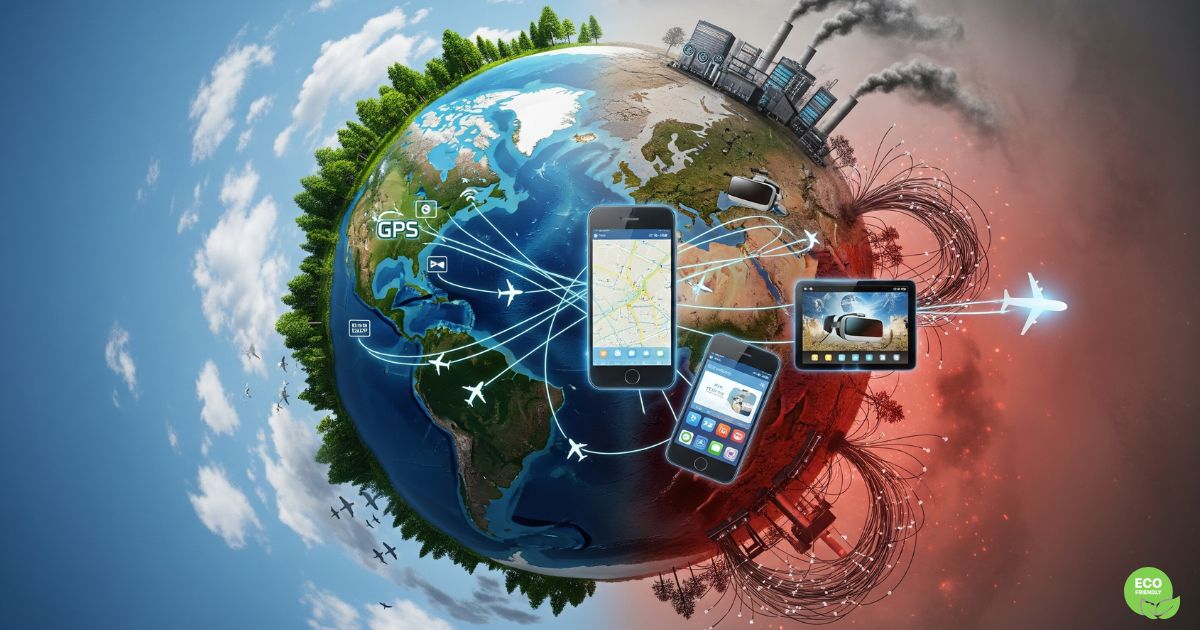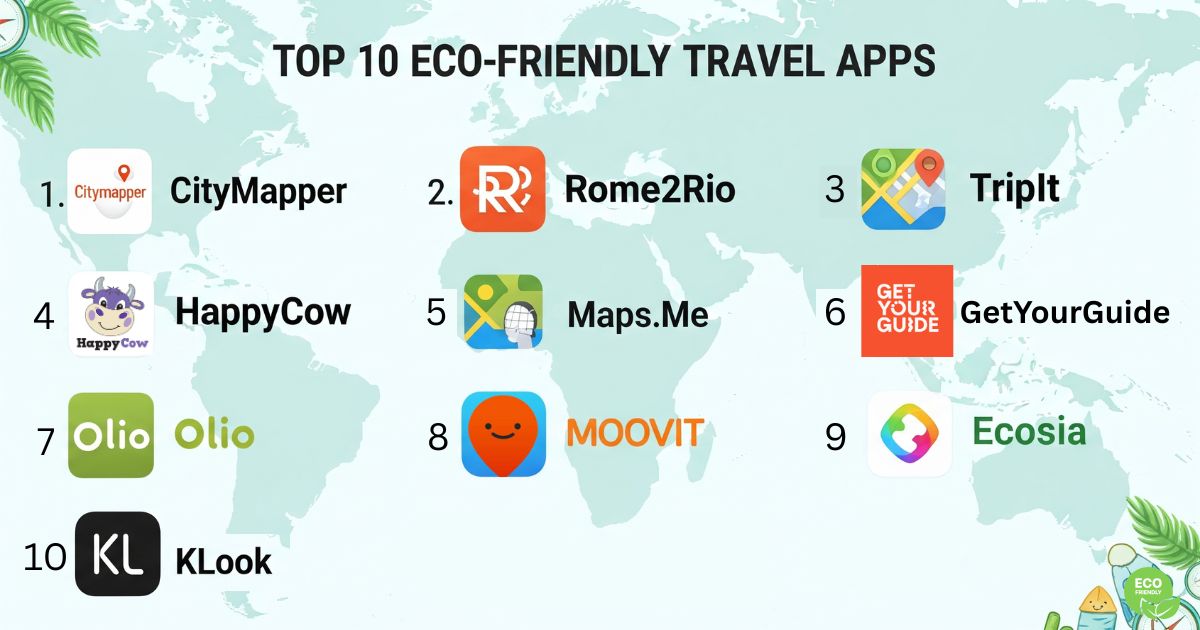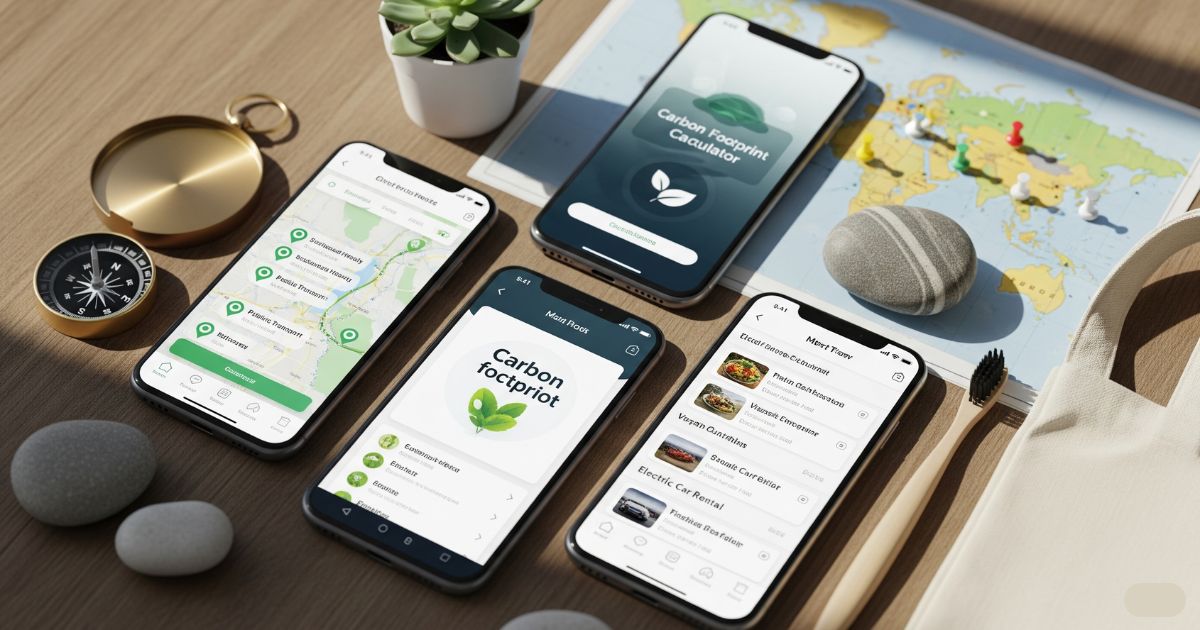
Sustainable travel has moved from a niche interest to a mainstream necessity. Modern travelers increasingly seek ways to reduce their environmental impact without sacrificing the joy of exploration. The right travel apps can transform how you plan, navigate, and experience destinations while making environmentally conscious choices every step of the way.
Technology has evolved to support eco-friendly planning in remarkable ways. From carbon footprint trackers that help you understand your travel impact to public transit apps that guide you away from gas-guzzling taxis, sustainable travel technology puts powerful tools in your pocket. These green apps don’t just help the planet—they often save money, connect you with local communities, and create more authentic travel experiences.
Whether you’re planning a weekend getaway or a months-long adventure, the following travel apps will help you make smarter, greener choices throughout your journey.
Understanding Sustainable Travel Technology
Before diving into specific apps, it’s worth understanding how sustainable travel technology works. These tools typically focus on three key areas: reducing transportation emissions, minimizing waste, and supporting local economies.
Transportation accounts for the largest portion of travel’s environmental impact. Smart apps help by promoting public transit, walking, cycling, and shared transportation options. They also provide accurate carbon footprint calculations so you can make informed decisions about flights, accommodation, and activities.
Waste reduction features include digital tickets, offline maps that reduce data usage, and local guides that connect you with sustainable businesses. Many apps also prioritize supporting local economies by highlighting locally-owned restaurants, shops, and tour operators.
The Top 10 Eco-Friendly Travel Apps

1. Citymapper
Citymapper revolutionizes urban navigation by making public transportation the easiest option. This comprehensive public transit app works in over 40 cities worldwide, providing real-time departure information, route planning, and even crowdsourced disruption alerts.
The app excels at combining different transportation modes into single journeys. It might suggest walking to a bus stop, taking the bus to a subway station, then finishing with a short bike ride. This multimodal approach often proves faster than driving while dramatically reducing your carbon footprint.
Citymapper’s environmental benefits extend beyond just route suggestions. The app calculates calories burned for walking and cycling portions of your journey, encouraging active transportation. It also shows comparative journey times and costs, making sustainable options more appealing.
2. Rome2Rio
Planning sustainable transportation between cities becomes simple with Rome2Rio. This comprehensive platform searches flights, trains, buses, ferries, and driving options, then displays them with clear environmental and cost comparisons.
The app shines when revealing less obvious transportation options. You might discover that a scenic train journey costs less than flying while producing significantly fewer emissions. Rome2Rio includes booking links for most options, streamlining the entire planning process.
For longer journeys, Rome2Rio helps you understand the true environmental cost of different choices. The app doesn’t just show flight options—it reveals overland alternatives that many travelers never consider.
3. TripIt
Digital organization reduces paper waste while improving travel efficiency. TripIt automatically organizes your travel documents, confirmations, and itineraries into a single, accessible format. Forward your confirmation emails to the app, and it builds a complete trip timeline.
The environmental benefits go beyond paperless travel. TripIt’s Pro version includes real-time flight alerts, helping you avoid unnecessary trips to the airport during delays. The app also suggests nearby restaurants and attractions, reducing the need for printed guidebooks and maps.
TripIt integrates with calendar apps and shares itineraries with travel companions, ensuring everyone stays coordinated without printing multiple copies of documents.
4. Maps.Me
Reliable offline maps reduce data usage and ensure navigation capability in areas with poor connectivity. Maps.Me downloads detailed maps for entire countries or regions, providing turn-by-turn navigation without internet access.
The app particularly excels at showing walking and cycling routes often missed by car-focused navigation systems. Detailed topographic information helps hikers and outdoor enthusiasts explore responsibly without getting lost.
Maps.Me includes points of interest like restaurants, hotels, and attractions, all accessible offline. This reduces the need for printed materials while helping travelers discover local businesses that might not appear in mainstream guidebooks.
5. HappyCow
Finding sustainable dining options becomes effortless with HappyCow, the world’s most comprehensive guide to vegetarian and vegan restaurants. The app includes over 180,000 listings worldwide, from fully plant-based restaurants to traditional establishments with strong vegetarian options.
Beyond restaurant listings, HappyCow helps travelers understand local food culture and sustainable dining practices. User reviews often highlight locally-sourced ingredients, organic options, and environmentally conscious restaurants.
The app’s community features connect like-minded travelers and locals. Many users share recommendations for farmers’ markets, health food stores, and sustainable food experiences that don’t appear in conventional guidebooks.
6. Olio
Reducing food waste while traveling becomes possible with Olio, an app that connects people with surplus food in their local area. Users share everything from restaurant leftovers to excess groceries, creating a community-driven solution to food waste.
For travelers, Olio provides access to free or low-cost food while supporting waste reduction efforts. The app works particularly well in urban areas where restaurants, cafes, and grocery stores regularly share surplus items.
Olio also facilitates the sharing of non-food items, helping travelers find or share items they might otherwise buy or discard. This peer-to-peer sharing reduces consumption while fostering connections with locals.
7. Moovit
Public transit navigation reaches new levels of sophistication with Moovit, which serves over 3,400 cities across 100+ countries. The app provides real-time public transit information, helping travelers navigate unfamiliar transportation systems confidently.
Moovit‘s strength lies in its crowdsourced data. Local users contribute real-time information about delays, disruptions, and service changes, ensuring accuracy even in cities where official transit data might be limited.
The app includes accessibility information, helping travelers with mobility needs find suitable routes. This inclusive approach ensures sustainable transportation options remain available to all travelers.
8. Ecosia
Sustainable search functionality might seem minor, but Ecosia transforms every travel-related search into environmental action. This search engine uses ad revenue to fund tree-planting projects worldwide, with over 150 million trees planted so far.
For travel planning, Ecosia works exactly like conventional search engines while contributing to reforestation efforts. Travelers can research destinations, find accommodation, and discover activities while supporting environmental restoration projects.
The app provides transparency about its environmental impact, showing users how their searches contribute to specific planting projects. This creates a direct connection between everyday digital activities and environmental action.
9. GetYourGuide
Discovering sustainable tourism activities becomes easier with GetYourGuide’s growing selection of eco-friendly tours and experiences. The platform increasingly features carbon-neutral tours, wildlife conservation experiences, and community-based tourism options.
The app’s filtering options help travelers identify sustainable activities, from walking tours that require no transportation to conservation projects where tourists contribute to environmental protection efforts. Many experiences directly support local communities and environmental initiatives.
GetYourGuide‘s review system helps travelers identify truly sustainable operators versus those merely using green marketing. Detailed descriptions often specify environmental practices and community benefits.
10. Klook
Activity booking with environmental consciousness becomes straightforward through Klook’s expanding sustainable tourism options. The platform partners with operators offering eco-friendly experiences, from electric vehicle tours to wildlife conservation activities.
Klook‘s digital ticketing eliminates paper waste while providing instant confirmation and easy rebooking options. The app often features bundle deals that encourage longer stays in fewer destinations, reducing transportation emissions.
The platform’s local focus helps travelers discover authentic experiences that support local economies. Many featured activities emphasize cultural preservation and environmental protection, aligning entertainment with sustainable values.
Maximizing Your Eco-Friendly Travel Apps

Getting the most from these travel apps requires strategic thinking about how they work together. Start your planning with Rome2Rio to identify sustainable transportation options, then use Citymapper or Moovit to navigate efficiently once you arrive.
Download Maps.Me content before traveling to reduce data usage and ensure navigation capability in remote areas. Use TripIt to organize all your confirmations digitally, eliminating the need for printed documents.
For dining and activities, combine HappyCow with GetYourGuide and Klook to find experiences that align with your values. Check Olio regularly to reduce food waste and connect with local communities.
Consider your phone’s battery life when using multiple apps. Offline maps and cached information reduce battery drain while maintaining functionality in areas with limited charging options.
The Environmental Impact of Digital Travel Tools
While travel apps themselves consume energy through data centers and device usage, their environmental benefits far outweigh their digital footprint. Public transit apps alone can reduce urban transportation emissions by encouraging sustainable travel choices.
The shift from printed materials to digital tools eliminates significant paper waste. Consider that a single comprehensive guidebook might weigh several pounds and require substantial resources to produce and distribute. Digital alternatives provide more current information with minimal environmental impact.
Carbon footprint tracking features in travel apps create awareness that often leads to behavior change. When travelers can see the environmental impact of their choices, they frequently choose more sustainable options even when they cost slightly more or take additional time.
Looking Forward: The Future of Sustainable Travel Technology
Sustainable travel technology continues evolving rapidly. Artificial intelligence increasingly powers smarter route suggestions that balance efficiency with environmental impact. Machine learning helps apps understand individual preferences while suggesting greener alternatives.
Integration between different platforms improves constantly. Soon, booking a train ticket might automatically add the journey to your trip organizer while suggesting nearby sustainable restaurants and activities.
Carbon offset integration represents another growing trend. Apps increasingly offer direct carbon offset purchasing, making it easy to compensate for unavoidable emissions while supporting environmental projects worldwide.
Making Every Journey Count
The intersection of technology and sustainable travel offers unprecedented opportunities for conscious exploration. These travel apps don’t require sacrificing convenience or discovery—they enhance both while reducing environmental impact. This section acts as a practical Sustainable Travel Guide for using technology to plan greener trips.
Start by choosing two or three apps that align with your travel style and destinations. Master their core features before adding additional tools. Remember that the most sustainable app is the one you actually use consistently.
Sustainable travel technology works best when combined with mindful planning. Use these tools to make informed decisions, but don’t let perfect become the enemy of good. Every small step toward more sustainable travel practices contributes to positive environmental change.
Download a few of these eco-friendly planning tools before your next trip. You might discover that sustainable travel options are more convenient, affordable, and enjoyable than you imagined.

















No Comments